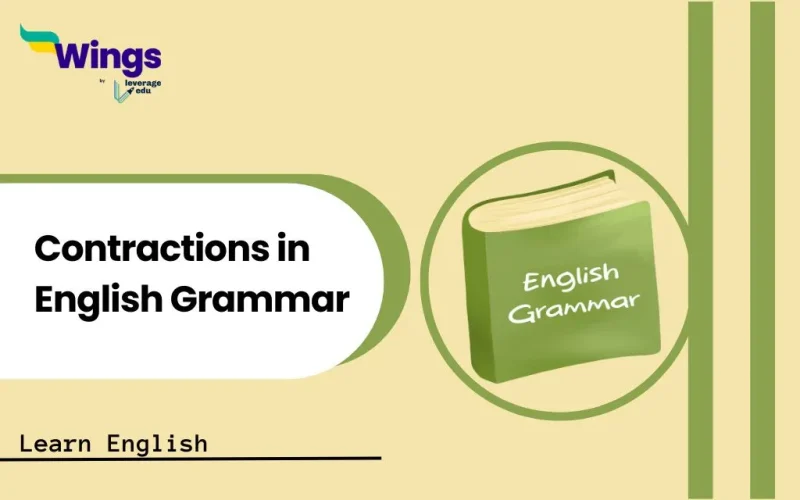Ever wondered why native English speakers sound so smooth and natural when they talk? One big reason is contractions! These small shortcuts help make speech and writing sound more casual, friendly, and fluent. Instead of saying “I am going to the store,” people often say “I’m going to the store.” See how much easier and natural it sounds? That’s the power of contractions in English Grammar.
In this guide, you will learn what contractions are, how to use them correctly, and when to avoid them. Plus, we’ll give you some fun exercises to practice. Whether you are learning English, improving your writing, or just curious, this article will help you master how to use contractions in English as a pro!
This Blog Includes:
What are Contractions in English Grammar?
A contraction is a shortened form of two words combined into one by omitting one or more letters and replacing them with an apostrophe (’). They are commonly used in informal writing and speech to make sentences flow more naturally.
Here are some examples of contractions in English grammar:
| I am | I’m |
| You are | You’re |
| He will | He’ll |
| Do not | Don’t |
Why are Contractions Important?
Using contractions makes English sound more natural and engaging. Imagine someone saying, “I do not know where he is.” Versus “I don’t know where he is.” The second sentence sounds more fluid and conversational.
Also Read: How to Use Apostrophe with Contractions
How to Use Contractions in English Grammar?
Here are some important rules and tips for using contractions in English grammar effectively:
1. Use Contractions in Informal Writing and Speech
Contractions are perfect for everyday conversations, casual writing, and digital communication, such as:
- Text messages
- Social media posts
- Blogs
- Fiction writing
2. Know When to Avoid Contractions
While contractions make speech and informal writing sound natural, there are situations where they may not be appropriate:
- Academic Writing: Essays, research papers, and formal reports should generally avoid contractions.
- Professional Emails: In formal business emails, using full words instead of contractions is often preferred.
- Legal & Official Documents: Contracts, agreements, and other legal paperwork should be written with full words for clarity.
3. Be Mindful of Apostrophe Placement
One common mistake is placing the apostrophe incorrectly. Remember:
- It’s means “it is” or “it has,” while its (without an apostrophe) is a possessive pronoun.
- They’re means “they are,” while their is possessive, and there refers to a place.
- You’re means “you are,” while your is possessive.
4. Use Contractions to Improve Readability
If you’re learning English or creating content online, knowing how to use contractions correctly can improve readability and engagement.
- Higher Readability Score: Search engines favor content that is easy to read. Using contractions helps make text flow naturally.
- Improves User Experience: Readers prefer content that sounds conversational and engaging.
- Better Keyword Optimization: People search with contractions (e.g., “what’s the best way” instead of “what is the best way”). Including contractions in your content can align better with user search intent.
Also Read: 21+ Apostrophe Examples in Sentences as Punctuation Mark
List of Contractions in English
Here are some of the common contractions in English grammar that help you understand more about contractions:
Positive Contractions
Here are some positive contractions in English grammar:
| Contraction | Meaning |
| could’ve | could have |
| he’ll | he will |
| here’s | here is |
| how’d | how did, how would |
| how’ll | how will |
| how’s | how has, how is |
| how’re | how’re |
| he’d | he had, he would |
| he’s | he has, he is |
| I’d | I had, I would |
| I’ll | I will |
| let’s | let us |
| it’d | it had, it would |
| it’ll | it will |
| I’m | I am |
| it’s | it has, it is |
| I’ve | I have |
| must’ve | must have |
| might’ve | might have |
| should’ve | should have |
| somebody’s | somebody has, somebody is |
| she’d | she had, she would |
| she’ll | she will |
| she’s | she has, she is |
| someone’s | someone has, someone is |
| something’s | something has, something is |
| that’d | that would |
| you’ve | you have |
| you’d | you had, you would |
| you’ll | you will |
| you’re | you are |
| we’d | we had, we would |
| what’ve | what have |
| what’s | what has, what is |
| what’re | what are |
| what’ll | what will |
| what’d | what did |
| we’ve | we have |
| we’re | we are |
| we’ll | we will |
| when’s | when has, when is |
| where’d | where did |
| when’d | when did |
| where’re | where are |
| where’ll | where will |
| where’s | where has, where is |
| which’s which | has, which is |
| where’ve | where have |
| who’d | who did, who had, who would |
| who’ll | who will |
| who’s | who has, who is |
| who’re | who are |
| would’ve | would have |
| why’s | why has, why is |
| why’re | why are |
| why’d | why did |
| who’ve | who have |
| that’s | that has, that is |
| that’ll | that will |
| there’s | there has, there is |
| there’re | there are |
| these’ll | these will |
| these’re | these are |
| they’d | they had, they would |
| those’ll | those will |
| this’s | this has, this is |
| this’ll | this will |
| they’ve | they have |
| they’re | they are |
| they’ll | they will |
Negative Contractions
Here are some negative contractions in English grammar:
| aren’t | are not |
| can’t | can not |
| doesn’t | does not |
| couldn’t | could not |
| didn’t | did not |
| don’t | do not |
| hadn’t | had not |
| hasn’t | has not |
| haven’t | have not |
| isn’t | is not |
| mustn’t | must not |
| shouldn’t | should not |
| wasn’t | was not |
| won’t | will not |
| weren’t | were not |
| wouldn’t | would not |
Contractions in English Grammar Worksheets
To practice using contractions in English grammar, try these fun worksheets:
Worksheet 1: Fill in the Blanks
Complete the sentences by filling in the correct contraction:
- I ___ (do not) like spicy food.
- She ___ (will not) be attending the party.
- They ___ (are) going to the beach tomorrow.
- He ___ (has) already finished his homework.
- You ___ (should not) be late for class.
- We ___ (have) been waiting for an hour.
- He ___ (is) not interested in football.
- It ___ (would) be nice to see you again.
- I ___ (cannot) believe how fast time flies.
- She ___ (did not) finish her homework on time.
Answers:
- don’t
- won’t
- ‘re
- ‘s
- Shouldn’t
- We’ve
- He’s
- It’d
- Can’t
- Didn’t
Worksheet 2: Rewrite the Sentences
Rewrite the following sentences using contractions:
- I will call you later.
- She is watching a movie.
- They have finished their homework.
- You are my best friend.
- He does not like cold weather.
- We are planning a trip next week.
- She has never been to Paris.
- I cannot believe this is happening!
- It is raining outside.
- They will not be able to attend the wedding.
Answer:
- I’ll call you later.
- She’s watching a movie.
- They’ve finished their homework.
- You’re my best friend.
- He doesn’t like cold weather.
- We’re planning a trip next week.
- She’s never been to Paris.
- I can’t believe this is happening!
- It’s raining outside.
- They won’t be able to attend the wedding.
Fun Facts About Contractions
Here are some fun facts about contractions in English:
- The word “won’t” is an irregular contraction of “will not” (instead of “willn’t”).
- Some contractions can have different meanings based on context. For example, “he’s” can mean “he is” or “he has.”
- Double contractions exist in English, such as “I’d’ve” (I would have), though they are not commonly used in writing.
Also Read: How to Use Apostrophes? Learn 3 Golden Rule
FAQs
Q1. What are contractions in English grammar?
Contractions are shortened forms of words created by combining two words and replacing missing letters with an apostrophe (’). For example, “do not” becomes “don’t”, and “I am” becomes “I’m”.
Q2. Why do we use contractions?
Contractions make speech and writing sound more natural, conversational, and fluid. They help make sentences shorter and more engaging.
Q3. Are contractions formal or informal?
Contractions are generally considered informal and are used in spoken English, casual writing, and creative content. However, they are usually avoided in formal writing like academic papers, business reports, and legal documents.
Q4. What are some common contractions in English?
Here are a few common contractions:
I am → I’m
You are → You’re
He is → He’s
Do not → Don’t
Cannot → Can’t
They will → They’ll
5. How do I form contractions correctly?
To form a contraction:
Combine two words into one.
Remove one or more letters.
Replace the missing letters with an apostrophe (’). For example: She is– She’s
Related Reads
We hope this blog on “How To Use Contractions in English Grammar” helped you improve your English skills. You can also follow the Learn English page of Leverage Edu for more exciting and informative blogs related to English grammar and the English language
 One app for all your study abroad needs
One app for all your study abroad needs















 60,000+ students trusted us with their dreams. Take the first step today!
60,000+ students trusted us with their dreams. Take the first step today!

